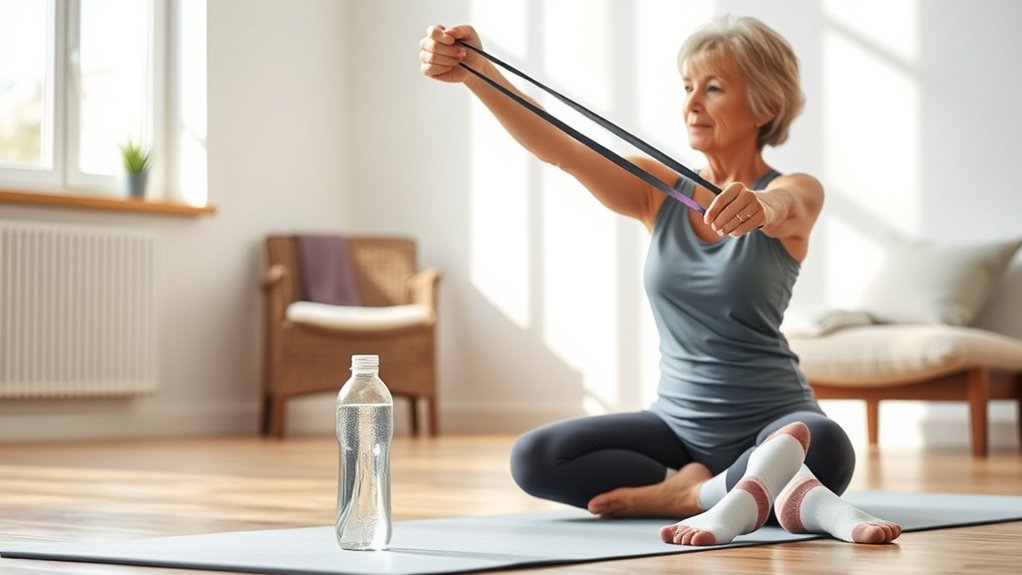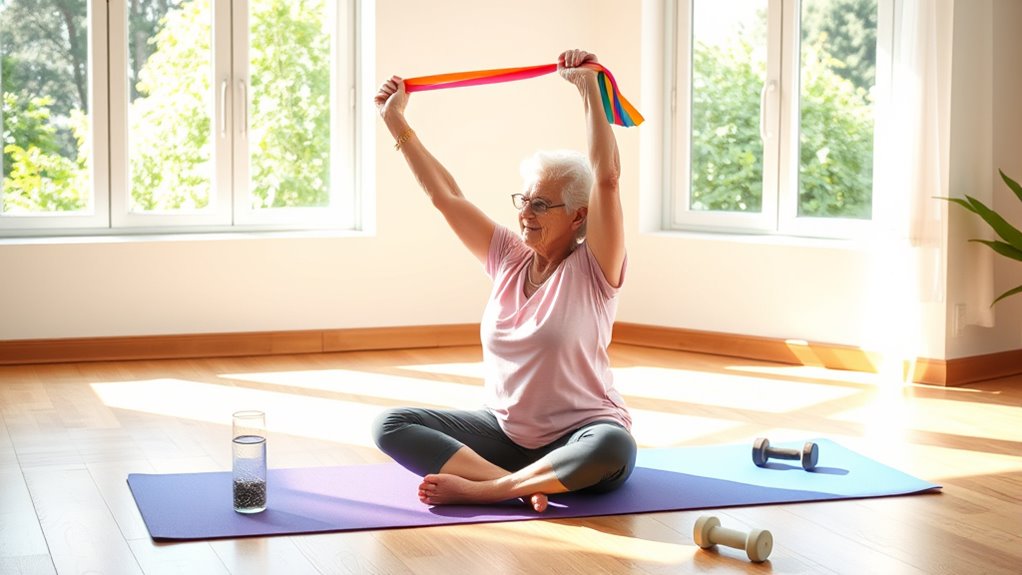Stretch band exercises are perfect for seniors looking to stay limber and improve flexibility. These low-impact workouts enhance your range of motion and strengthen muscles without straining your joints. Choose from various resistance levels to match your comfort and ability, starting light and progressing gradually. Remember to warm up before each session to prepare your body and reduce injury risks. There’s so much more to explore about specific exercises and tips for success.
Key Takeaways
- Stretch band exercises improve flexibility and expand the range of motion, essential for daily activities in seniors.
- Light to medium resistance bands are ideal for seniors, promoting strength without strain or discomfort.
- Incorporating warm-up activities helps prepare muscles and joints, reducing the risk of injury during exercises.
- Exercises like seated abduction and leg press effectively target key muscle groups while enhancing mobility and strength.
- Setting achievable goals and maintaining a consistent workout schedule fosters motivation and tracks progress in fitness.
Benefits of Stretch Band Exercises for Seniors

Stretch band exercises offer a range of benefits that can greatly enhance your quality of life as a senior.
These exercises improve flexibility, expanding your range of motion and making daily functional activities easier. By providing low-impact resistance training, stretch bands help you combat age-related muscle loss while boosting muscle strength without straining your joints. Engaging in regular physical activity also contributes to good grief by promoting emotional well-being. Additionally, consistent exercise can play a role in creating a retirement savings plan by encouraging a healthier lifestyle that may reduce future medical expenses. Research indicates that regular physical activity can lead to a significant reduction in stress levels, making it easier to manage daily challenges. Moreover, incorporating self-care practices into your routine can further enhance your overall well-being.
Stretch band exercises enhance flexibility and strength, making daily activities easier while protecting your joints from strain.
You can adjust the bands to match your individual strength, ensuring a personalized workout experience. Regularly engaging in stretch band exercises enhances your balance and stability, markedly reducing the risk of falls.
This means you can move confidently and maintain your independence, making everyday tasks less painful and more manageable, especially if you deal with conditions like arthritis. Additionally, regular exercise, including daily exercise requirements, is crucial for preventing obesity and related health issues as you age.
Types of Resistance Bands for Seniors

When choosing resistance bands, it’s important to understand the different types available to you.
You’ll find options that range in resistance levels, allowing you to select what suits your fitness needs best. Incorporating regular physical activity into your routine can significantly enhance your overall health and well-being. Additionally, diversification in your exercise regimen can help improve overall strength and flexibility. Using resistance bands can also provide essential support for maintaining muscle tone as you age. Moreover, engaging in physical activity for seniors can further contribute to improved mobility and independence.
Plus, focusing on durability and comfort can enhance your workout experience, making it easier to stick with your routine. Additionally, understanding toilet maintenance can help prevent issues that may arise from improper use of household equipment, allowing for a smoother exercise environment.
Band Types Overview
Choosing the right resistance band is essential for seniors looking to enhance their fitness routine safely. Opt for light resistance to guarantee a safe level of tension that won’t strain your muscles or joints. Air purifiers can also play a vital role in maintaining a healthy environment while you exercise by reducing allergens in the air. When selecting a resistance band, consider the importance of legalities and zoning regulations that may apply if you choose to incorporate outdoor spaces for your workouts. Engaging in creative practice through exercise not only improves physical health but also boosts mental well-being. Additionally, being mindful of your overall diet, including moderation in saturated fat consumption, can further support your fitness goals.
Resistance bands with handles are highly recommended; they provide a better grip and allow for a greater range of motion during exercises. Durable bands made from rubber or latex offer comfortable elasticity, making them suitable for regular workouts.
You’ll find long bands, loop bands, and bands with handles as the primary types available. Each type offers varying resistance levels, enabling customized workouts as your strength improves. Additionally, consider bands with user-friendly setups to make your exercise routine more convenient and enjoyable.
Resistance Levels Explained
Understanding resistance levels is essential for seniors aiming to enhance their fitness safely and effectively. Choosing the right resistance bands can help you build muscle while reducing the risk of injury. Here are some key points to evaluate:
- Light to Medium Resistance: Ideal for most seniors, these bands help in stretching exercises without straining muscles or joints. To further encourage proper usage, consider using scratching posts as a way to redirect any potential discomfort during exercises. Additionally, implementing the 50/30/20 rule in your fitness routine can help allocate time effectively for workouts. It’s important to remember that regular tick checks can also be a part of your overall health strategy as staying active outdoors is beneficial. Engaging in gentle stretching exercises can also enhance flexibility and mobility.
- Handles: Bands with handles provide a better grip, allowing for a greater range of motion during your exercise program.
- Durability: Rubber or latex bands offer comfortable elasticity, making them suitable for regular workouts.
- Progression: Start with lighter resistance and gradually increase as your strength improves, ensuring you challenge various muscle groups effectively.
Additionally, adopting an MVP (Minimum Viable Product) approach in your fitness routine can help you test new exercises safely. Consider consulting a personal trainer for personalized guidance!
Durability and Comfort
A variety of resistance bands can offer both durability and comfort, making them ideal for seniors.
Opt for light to medium resistance bands, as they provide enough challenge without straining your muscles and joints, ensuring safety during exercise.
Bands with handles are particularly helpful, giving you a better grip and enhancing your range of motion for more effective workouts.
Rubber or latex bands are known for their durability and comfortable elasticity, allowing for repeated use without breaking.
The LIT Axis Resistance Bands even feature built-in sensors to track movements, which can help you tailor your routine.
Incorporating high refresh rates in your exercise routine can enhance coordination and reaction times, similar to how they improve gaming experiences.
Safety Precautions Before Starting Exercises

Before diving into stretch band exercises, it’s important to prioritize your safety. Here are some key safety precautions to follow:
- Consult a healthcare provider: Before starting any new exercise routine, especially if you have pre-existing health conditions or injuries.
- Start with warm-up exercises: Engage in gentle activities like brisk walking or dynamic stretches to prepare your muscles and joints, reducing the risk of injury.
- Use the lightest resistance band: Begin with a low resistance to help your body acclimate, gradually increasing resistance as you gain strength.
- Monitor your body’s response: Pay attention to any pain or discomfort during exercises; adjust the resistance or stop if needed.
Lastly, always maintain proper form to maximize effectiveness and guarantee safety.
Importance of Warm-Up Exercises

Since warming up is essential for your workout routine, it’s important to incorporate warm-up exercises before diving into stretch band workouts. Engaging in activities like brisk walking or light cardio increases blood flow to your muscles, preparing your body for physical activity.
Dynamic stretches during your warm-up can help loosen muscles and joints, reducing the risk of injury while enhancing your workout effectiveness. For older adults, a proper warm-up not only decreases muscle stiffness but also improves flexibility.
Aim for a warm-up that lasts 5 to 10 minutes, reaching a comfortable level of breathlessness. By taking the time to warm up, you’re setting yourself up for a safer and more effective exercise session.
Recommended Stretch Band Exercises

Stretch bands offer great benefits for improving your flexibility and strength, helping you stay independent in daily life.
You can try essential exercises like seated abduction, leg press, and lateral raises to target different muscle groups safely.
Remember to hold each stretch for 15 to 30 seconds and repeat for the best results.
Benefits of Stretch Bands
Using stretch bands can greatly enhance your fitness routine, especially as you age. They’re an excellent tool for improving flexibility and joint health while providing resistance workouts tailored to your needs.
Here are some key benefits:
- Adjustable Tension: Customize workouts to your strength level and gradually increase resistance.
- Muscle Strength: Effectively target various muscle groups to build strength and combat age-related muscle loss.
- Balance and Stability: Strengthen stabilizer muscles, which are essential for everyday activities and reducing injury risk.
- Overall Health: Incorporating stretch band exercises can alleviate arthritis pain and improve your mobility, making you feel more active and independent.
Embrace stretch bands to maintain your energy and enhance your quality of life!
Essential Stretching Techniques
Incorporating resistance bands into your stretching routine can make a notable difference in your flexibility and strength as you age.
Resistance band exercises, such as seated abduction and leg presses, enhance your range of motion and functional fitness. Focus on maintaining proper form by using controlled movements; this helps you avoid strain and reduces the risk of injury.
Stretching with resistance bands not only alleviates stiffness but also improves balance, which is vital for fall prevention among seniors. Aim to hold each gentle stretch for 15 to 30 seconds, allowing your muscles to relax and adapt.
How to Choose the Right Resistance Level

When you’re choosing the right resistance level for your exercises, it’s essential to find a balance that challenges your muscles without causing discomfort. Here are some tips to guide you:
- Opt for bands that offer light to medium resistance, ensuring they challenge you without causing discomfort or strain.
- Select a resistance level that allows for complete movement, safeguarding your joints during exercises.
- Gradually increase resistance as your strength improves, ensuring you maintain proper form.
- Always pay attention to your body’s response; if you feel discomfort, switch to a lighter band for safety during exercises.
Consult with a healthcare provider to assess your individual fitness level and get personalized recommendations on suitable resistance levels for your workouts.
Incorporating Stretch Bands Into Your Routine

Finding the right resistance level sets the stage for successfully incorporating stretch bands into your routine.
These versatile tools enhance flexibility and mobility, which are vital for seniors. By adjusting the resistance, you can tailor exercises to suit your strength and comfort, making workouts more accessible.
Aim for 2 to 3 sessions each week, mixing different exercises to engage various muscle groups and improve overall fitness. Regular use of resistance bands also boosts balance and stability, essential for fall prevention.
Plus, their lightweight and portable nature means you can easily work out at home or while traveling. Embrace strength training with stretch bands to keep your body limber and active as you age.
Stretch Band Exercises for Injury Recovery

Stretch band exercises play an essential role in injury recovery, as they help rebuild strength and flexibility in affected muscles while minimizing stress on injured areas.
Stretch band exercises are vital for injury recovery, rebuilding strength and flexibility while reducing stress on vulnerable muscles.
These effective resistance band exercises are often used in physical therapy and can help you regain muscle mass safely. Here are some key benefits:
- Low-impact resistance training: Reduces stress on joints while promoting healing.
- Adjustable tension: Start with lighter resistance and increase as you gain strength.
- Exercises that target: Specific movements like seated abduction and leg presses focus on weakened muscles.
- Promotes blood flow: Enhanced circulation aids in faster recovery.
Always consult your healthcare provider before starting to guarantee a safe and effective recovery plan tailored to your needs.
Tips for Staying Motivated With Stretch Band Workouts

After focusing on recovery with stretch band exercises, staying motivated in your routine is key to achieving long-term benefits. Here are some tips to keep your momentum going:
| Tip | Description |
|---|---|
| Set Achievable Goals | Aim for specific targets like repetitions or new exercises. |
| Incorporate Variety | Change exercises and resistance levels to keep it fresh. |
| Join a Community | Engage with others for support and motivation. |
Create a consistent workout schedule of 2 to 3 sessions per week. Document your progress in a workout journal, noting improvements in flexibility and strength. This reflection can boost your motivation and help you stay limber as you continue your resistance band workouts.
Frequently Asked Questions
Is Resistance Band Training Good for Seniors?
Absolutely, resistance band training is great for seniors!
It helps you build muscle strength and flexibility without putting too much strain on your joints. You can easily adjust the resistance level to fit your comfort and strength, making it a safe choice.
Plus, regular use can improve your balance and stability, reducing the risk of falls. Incorporating these bands into your routine can also boost your heart health, keeping you active and healthy.
What’s the Best Exercise for a 70 Year Old?
As you navigate the golden years, think of your body as a finely tuned instrument, needing gentle maintenance to keep playing its beautiful melody.
For a 70-year-old, the best exercise often involves low-impact activities like walking, swimming, or light resistance training. These options boost strength and flexibility without straining your joints.
Always remember to consult a healthcare professional before diving into a new routine, ensuring you tailor exercises to your unique health needs.
Can Resistance Bands Help With Flabby Arms?
Yes, resistance bands can definitely help with flabby arms. They effectively target your triceps and biceps, toning and strengthening those muscles.
By incorporating exercises like bicep curls and tricep extensions into your routine, you’ll enhance muscle definition and improve overall arm strength.
Plus, regular resistance training can increase muscle mass, boost your metabolism, and promote fat loss, helping you achieve firmer, more toned arms over time.
How to Use Resistance Bands for Legs for Seniors?
To use resistance bands for legs, start by sitting on a sturdy chair.
Loop the band around your feet and extend your legs forward for a Leg Press, aiming for 10-12 reps.
For a Calf Press, keep the band around one foot, point your toes, and press down, doing 10-15 reps per foot.
Adjust the band’s tension to match your strength, helping improve mobility and stability while reducing fall risks.
Conclusion
Incorporating stretch band exercises into your routine can truly enhance your flexibility and strength as you age. Many believe that seniors can’t build muscle or stay active, but research shows that resistance training can greatly improve mobility and overall health. By choosing the right resistance level and practicing safety precautions, you can enjoy the benefits of these exercises while minimizing injury risk. So, grab a band and start moving—staying limber is within your reach!









